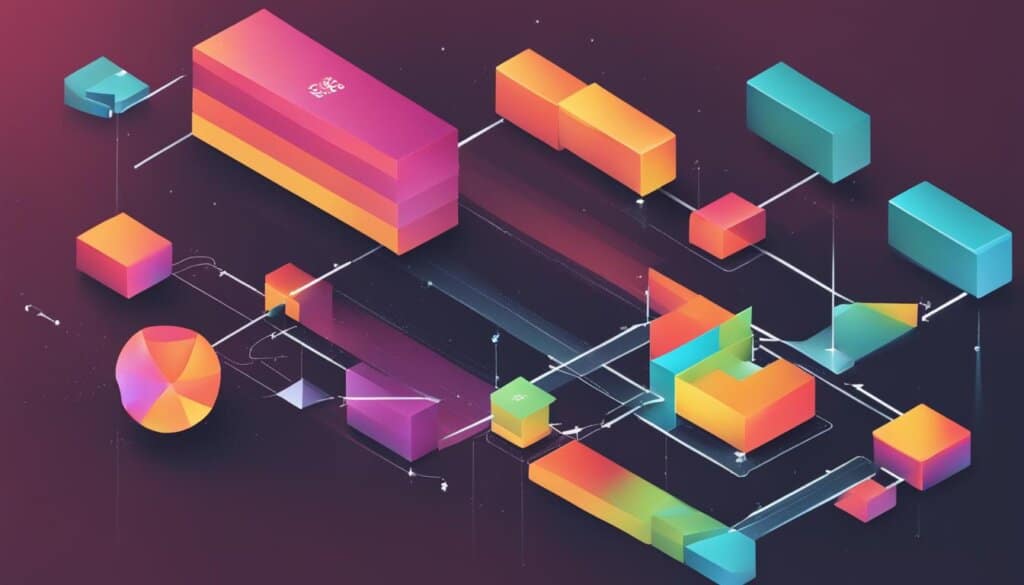Table of Contents
Product development is a critical process that drives business innovation and success. It involves strategizing, planning, building, and releasing a product to the market. The stages and strategies of product development are crucial in determining the importance and impact of the product in the market.
Product development goes beyond the build phase of the product lifecycle. It encompasses the “why,” “what,” and “when” of a product, requiring cross-functional collaboration from product management and engineering to product marketing.
The goal of product development is to create a product that customers love, ensuring its success in the market. It is a multidimensional process that involves understanding user needs, developing innovative solutions, and delivering a complete product experience.
In the following sections, we will explore the individuals involved in the product development process, the seven stages of product development, the need for product development, and the strategies for managing the process effectively. Additionally, we will discuss the importance of creating a comprehensive action plan to guide the product development journey.
Who is Involved in the Product Development Process?
The product development process is a collaborative effort that brings together various individuals and teams to create successful products. Among these key contributors are product managers, who play a crucial role in guiding the product’s success.
Product managers are responsible for setting the product’s strategy and vision. They work closely with stakeholders, including customers, to understand their needs and translate them into actionable goals. By defining product features and building a roadmap, product managers ensure that the product aligns with market demands and long-term company objectives.
However, product management is not a one-person job. It requires close collaboration with other teams and functions to create a cross-functional and holistic approach to product development.
The product team, consisting of representatives from product management, engineering, innovation, product marketing, and operations, works together to bring the product to life. Each member brings their expertise and perspective to the table, contributing to the creation of a complete product experience. Through their combined efforts, the product team ensures that all aspects of the product, from its technical specifications to its go-to-market strategy, are well-considered and aligned.
Additionally, other teams such as customer success, sales, finance, and legal also have a role to play in the product’s success. They provide valuable insights, support, and resources throughout the development process, contributing to the product’s overall success.
In a product-led organization, every member of the company plays an important role in understanding customers and delivering a complete product experience. While product managers and the product team may take the lead, a successful product development process requires the active involvement of all teams and stakeholders.
| Team | Role |
|---|---|
| Product Management | Set product strategy, build roadmap, define features |
| Engineering | Develop and bring the product to life |
| Innovation | Bring fresh ideas and drive product creativity |
| Product Marketing | Create go-to-market strategies and ensure successful product launches |
| Operations | Support product development through efficient processes and resources |
The Seven Stages of Product Development
Product development follows a well-defined process consisting of seven stages. Each stage plays a crucial role in bringing an innovative idea to life. Let’s explore these stages to understand the journey of turning ideas into successful products.
1. Strategize
In this initial stage, the product development team collaborates to strategize and define clear goals and initiatives. This involves identifying target markets, assessing customer needs, and determining the product’s value proposition.
2. Ideate
The ideation stage is all about capturing and refining promising ideas. This is when the team brainstorms and explores different concepts and possibilities. Creative thinking and ideation techniques are employed to generate innovative solutions and features that align with the product’s goals.
3. Plan
During the planning stage, a well-defined product roadmap is built. This roadmap outlines the detailed steps, timelines, and resources required to bring the product to life. The team estimates the product’s value, creates a budget, and sets priorities for development.
4. Build
The build stage is where the product is developed and brought to life. Engineers and developers work together to prototype, design, and build the product. This stage involves iterative development, constantly refining the product based on feedback and testing.
5. Launch
The launch stage marks the exciting moment when the product is introduced to the market. A well-executed product launch involves creating a buzz, generating awareness, and ensuring a successful market entry. Marketing, sales, and PR efforts play a vital role in driving adoption and attracting customers.
6. Analyze
After the product is launched, the analyze stage comes into play. This stage involves evaluating the product’s performance, gathering user feedback, and analyzing data to measure its success. Insights gained during this stage help in making informed decisions regarding further improvements and iterations.
By following this structured and iterative approach to product development, businesses can increase their chances of creating successful, innovative products that meet customer needs and drive business growth.
| Stage | Actions |
|---|---|
| Strategize | Define goals, create initiatives |
| Ideate | Capture and refine ideas, explore possibilities |
| Plan | Build a product roadmap, estimate value |
| Build | Prototype, design, and develop the product |
| Launch | Introduce the product to the market |
| Analyze | Evaluate performance, gather feedback, analyze data |
Understanding the Need for Product Development
Before diving into the stages of product development, it is important to understand the need for product development. Front-end innovation plays a crucial role in this process, as it helps identify design criteria, analyze ideas, and mature concepts. By focusing on front-end innovation, businesses can ensure that their products meet the expectations and needs of their target audience. This stage sets the foundation for a successful product development journey.
Idea generation is another vital aspect of product development. It involves generating innovative and unique product ideas based on identified gaps in the market. This phase encourages creativity and unlocks new possibilities for product offerings. By generating a wide range of ideas and exploring various angles, businesses can increase their chances of creating breakthrough products.
Idea screening is a critical step in the product development process. It involves evaluating and eliminating unattractive or unfeasible ideas. Through rigorous screening, businesses can focus their efforts and resources on the most promising ideas, maximizing their chances of success.
Concept development is where ideas start taking shape. This stage involves finalizing the legal and pragmatic aspects of the product. It includes activities such as patent filing, copyright protection, and refining the product’s features and functionalities. Concept development ensures that the product is legally sound and aligns with the overall business strategy.
Market strategy or business analysis is an integral part of product development. It involves identifying target markets, understanding customer needs and preferences, and formulating effective marketing strategies. By conducting thorough market research and analysis, businesses can position their product in the market effectively and optimize their chances of success.
Product evaluation is the final stage of product development before its launch. It involves testing the product in real usage scenarios to assess its performance, quality, and usability. By gathering feedback from users and analyzing their experiences, businesses can make necessary improvements and fine-tune the product to meet customer expectations. Product evaluation helps ensure that the final product is ready for a successful launch.
Benefits of Front-End Innovation in Product Development
Front-end innovation is a critical component of successful product development, offering several benefits:
- Promotes customer-centricity by focusing on understanding customer needs and preferences.
- Drives innovation and creativity by encouraging the generation of new and unique ideas.
- Reduces the risk of developing products that may not meet market demands or expectations.
- Enhances the overall quality and relevance of the final product.
- Increases the competitive advantage of the business by delivering products that stand out in the market.

Front-End Innovation Process
Front-end innovation typically follows a structured process:
- Identify customer needs and preferences through market research and user feedback.
- Analyze market trends and identify gaps or opportunities.
- Generate a wide range of product ideas to address the identified gaps and opportunities.
- Conduct idea screening and evaluation to filter out unattractive or unfeasible ideas.
- Refine and develop the selected ideas into viable concepts.
- Validate concepts through customer feedback and testing.
- Finalize the concept and prepare it for the next stages of product development.
Front-end innovation is a continuous process that requires businesses to stay agile, adapt to market changes, and proactively seek opportunities for improvement and growth.
| Front-End Innovation Process | Benefits |
|---|---|
| Identify customer needs | Ensures that the product addresses real customer pain points and delivers value. |
| Generate product ideas | Unleashes creativity and opens up new possibilities for product offerings. |
| Idea screening and evaluation | Focuses resources on the most promising ideas and minimizes risks. |
| Refine and develop concepts | Shapes the product and aligns it with the business strategy and market demands. |
| Validate concepts through testing | Ensures that the final product meets quality and performance standards. |
Front-end innovation is a vital driver of successful product development. By understanding the need for product development and embracing front-end innovation, businesses can create products that resonate with customers and drive business growth.
Managing Product Development
Managing product development requires a holistic approach. Product management plays a vital role in guiding the strategies and tactics behind the go-to-market plan. Cost analysis ensures efficient production and profitability. Product and industrial design help in creating a visually appealing and functional product. Intellectual property rights protect the product from infringement. Research and development and innovation contribute to continuous improvement and new product ideas.
Strategies and Tactics Guided by Product Management
The success of a product depends on effective product management. Product managers are responsible for setting product strategy, defining the target market, and identifying customer needs and preferences. They collaborate with cross-functional teams to ensure that the product meets the desired specifications and aligns with the overall business goals.
Efficient Production and Profitability through Cost Analysis
Cost analysis is essential to ensure that the product development process is cost-effective and profitable. It involves evaluating the costs associated with each stage of product development, including research and development, production, marketing, and distribution. By analyzing costs, companies can make informed decisions about pricing, budgeting, and resource allocation.
Creating Visually Appealing and Functional Products through Product and Industrial Design
Product and industrial design are crucial in creating products that are visually appealing, user-friendly, and functional. Designers consider aesthetics, ergonomics, and user experience to create products that align with market trends and customer preferences. Furthermore, industrial design ensures that the product can be efficiently manufactured and assembled.
Protecting the Product from Infringement through Intellectual Property Rights
Intellectual property rights safeguard the unique features and innovations of a product. By obtaining patents, trademarks, and copyrights, companies can prevent others from copying or profiting from their product. This protection encourages innovation and provides a competitive advantage in the market.
Continuous Improvement and New Product Ideas through Research and Development
Research and development (R&D) is essential for driving innovation and continuous improvement in product development. R&D activities involve exploring new technologies, materials, and methodologies to enhance product performance, efficiency, and functionality. By investing in R&D, companies can stay ahead of the competition and meet evolving customer demands.
Innovation as a Key Driver of Product Development Success
Innovation is at the heart of successful product development. It involves generating new ideas, exploring unconventional approaches, and challenging existing norms. By fostering a culture of innovation, companies can unlock new opportunities, disrupt markets, and create products that resonate with customers.
Creating a Product Development Action Plan
To successfully develop a product, it is important to create a comprehensive action plan. This plan should encompass various aspects crucial to the product’s success, such as design, packaging, and quality. By carefully considering these factors, businesses can ensure that their product stands out in the market and meets customer expectations.
One crucial step in the action plan is beta testing. By conducting beta testing, businesses can gather valuable feedback from users and make necessary improvements before the product launch. This helps in enhancing the overall user experience and ensuring that the product meets customer needs.
Cost control is another important factor to consider during product development. By implementing effective cost control measures, businesses can ensure efficient use of resources and avoid unnecessary expenses. This not only helps in maximizing profitability but also allows for more competitive pricing, increasing the product’s market appeal.
The product launch should be well-planned and supported by a robust marketing and distribution strategy. A well-executed launch can create a positive first impression of the product and generate initial customer interest. By carefully planning the launch activities and ensuring widespread product availability, businesses can maximize their chances of success.
Regular process reviews throughout the development cycle are vital for identifying areas that can be improved. By conducting thorough process reviews, businesses can learn from their experiences, refine their strategies, and continuously enhance their product development process. This iterative approach ensures that the product development process remains dynamic, adaptive, and aligned with the company’s goals and market demands.
FAQ
What is product development?
Product development is the process of strategizing, planning, building, and releasing a product to the market. It involves taking a product idea from concept to delivery and beyond.
Who is involved in the product development process?
The product development process involves various individuals and teams. Product managers, representatives from product management, engineering, innovation, product marketing, operations, customer success, sales, finance, and legal all have a role in the product’s success.
What are the seven stages of product development?
The seven stages of product development are: strategize, ideate, plan, build, launch, analyze.
Why is product development important?
Product development is important as it helps in identifying design criteria, analyzing ideas, maturing concepts, generating product ideas, finalizing legal and pragmatic aspects of the product, effectively selling the product, and testing the product in real usage scenarios.
How do you manage product development?
Managing product development requires a holistic approach. Product management plays a vital role in guiding the strategies and tactics behind the go-to-market plan. Cost analysis, product and industrial design, intellectual property rights, research and development, and innovation all contribute to the success of product development.
How do you create a product development action plan?
To create a comprehensive action plan, you should consider design, packaging, and quality. Beta testing helps in gathering feedback and making improvements. Cost control ensures efficient use of resources. A well-planned product launch supported by a robust marketing and distribution strategy, and regular process reviews also contribute to the overall success of the product development process.












